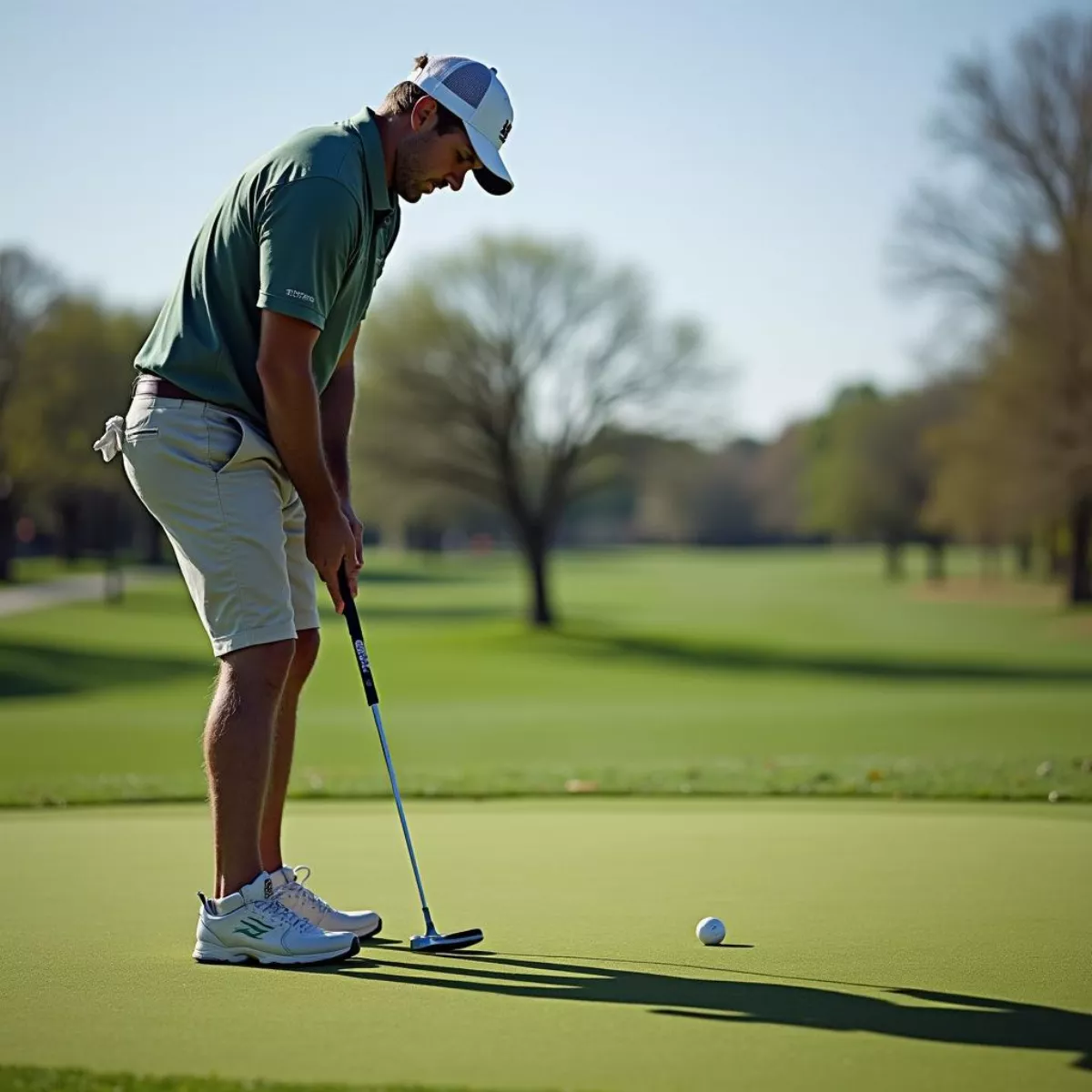Golf is a game that blends strategy, skill, and a pinch of luck. One term you’ll often hear among players and commentators is scramble. But what does scramble mean in the game of golf, and why is it crucial for golfers at all skill levels? In this article, we’ll dive into the intricacies of scrambling, explore its importance, and furnish you with tips to improve your scrambling skills.
What Does Scramble Mean in Golf?
Scrambling is a term that describes a golfer’s ability to recover from a bad shot or a challenging situation to make par or better. It typically comes into play when a golfer misses the green in regulation but manages to get up and down—meaning they successfully hit the ball onto the green in one stroke after their initial shot and then putt it into the hole.
 Golfer Chipping Ball onto Green
Golfer Chipping Ball onto Green
The Importance of Scrambling
In golf, minimizing mistakes is essential to score well. Scrambling allows golfers to maintain a respectable score, even when their driving or iron play falters. Scrambling effectively can lead to:
- Lower Scores: You can recover from mistakes and still maintain a low score.
- Mental Toughness: It builds confidence and mental resilience, crucial traits for competitive play.
- Strong Competition Edge: In tournaments, players who scramble well can excel, even when their game isn’t at its best.
When Is Scrambling Employed?
Scrambling often comes into play in various scenarios, including:
- Missed Greens: Whether a chunky shot or a push, if your ball lands off the green, you need to scramble.
- Challenging Lies: This could be in the rough, sand traps, or around hazards.
- Difficult Pin Positions: When the flag is tucked away behind obstacles, scrambling becomes essential.
Tips to Improve Your Scrambling Skills
To enhance your scrambling ability, consider these practical tips:
1. Develop Your Short Game
Short game proficiency is paramount for effective scrambling. Focus on:
- Chipping: Practice different types of chips—flop, pitch, and bump-and-run.
- Putting: Spend time honing your putting, as often a chip leads directly to a putt.
 Golfer Practicing Putting on the Green
Golfer Practicing Putting on the Green
2. Assess the Lie
Evaluating the ball’s lie is critical. Consider:
- Rough vs. Fairway: Rough lies will require different techniques than fairway lies.
- Sand Traps: Learn the art of bunker shots to effectively escape from sand.
3. Practice Under Pressure
Simulate pressure situations on the practice green. Set specific goals—like making a certain number of chips in a row before moving to the next drill.
4. Course Management
Strategize how you approach the hole. If you miss the green, think about where you want to leave the ball for the putt:
- Aim for a Flat Spot: Choose landing areas with fewer undulations.
- Know Your Yardages: Understand how far you can hit the ball from various lies.
5. Positivity and Mindset
Scrambling can be mentally taxing. Staying positive is vital. Visualization techniques can help:
- Before taking your second shot, visualize a successful recovery and putt. Positive imagery can translate into positive results.
 Golfer Lining Up Chip Shot Near Sand Trap
Golfer Lining Up Chip Shot Near Sand Trap
The Statistics Behind Scrambling
Understanding scrambling statistics can also provide insights into your performance.
| Scrambling Percentage | Description |
|---|---|
| 0-20% | Below average – improvement needed |
| 20-40% | Average – room for development |
| 40-60% | Good – consistent performances |
| Above 60% | Excellent – proficient scrambler |
A scrambling percentage over 60% is an indicator of a player who can consistently save par or better after missing greens.
Famous Scramblers
Throughout golf history, certain players have made their mark with extraordinary scrambling abilities. Here are a few:
- Phil Mickelson: Known for his short game finesse, Mickelson is often cited as one of the best scramblers in golfing history.
- Jordan Spieth: His ability to recover from tricky situations has played a significant role in his success.
- Greg Norman: Even when things went awry, Norman often found a way to salvage a good score.
Key Takeaways
- Understanding Scrambling: Scrambling is crucial for recovering from missed greens and maintaining scores.
- Short Game Mastery: Focus on chipping and putting to improve your scrambling skills.
- Evaluate the Lie: Always assess your ball’s lie before making recovery decisions.
- Practice Under Pressure: Simulated pressure situations can enhance your scrambling capabilities.
- Maintain Positivity: A positive mindset can significantly affect your scrambling success.
Frequently Asked Questions (FAQ)
1. What is the definition of scrambling in golf?
Scrambling in golf refers to the ability of a golfer to recover from a missed green and still make par or better.
2. Why is scrambling important?
Scrambling is important because it allows golfers to minimize mistakes and maintain lower scores, which can be critical in competitive play.
3. How can I improve my scrambling skills?
You can improve your scrambling skills by focusing on your short game, practicing under pressure, and employing effective course management strategies.
4. What is a good scrambling percentage?
A good scrambling percentage is typically above 40%. Players with over 60% are often considered excellent scramblers.
5. How often do professional golfers scramble?
Professional golfers often scramble, especially in challenging conditions; their scrambling percentage plays a significant role in their overall scoring.
6. How does scrambling contribute to a golfer’s mental toughness?
Consistently having the ability to recover from poor shots builds confidence and mental resilience, which are crucial for competitive play.
7. Can you scramble without a good short game?
While having a proficient short game enhances your scrambling ability, it is still possible to scramble effectively by strategizing and managing course conditions wisely.
8. Is there a specific practice drill for scrambling?
Yes, you can create scenarios where you intentionally miss greens and practice getting up and down from various lies.
9. Who are some famous golfers known for their scrambling skills?
Famous scramblers include Phil Mickelson, Jordan Spieth, and Greg Norman, all recognized for their short game proficiency.
10. How does course management affect scrambling?
Understanding the course layout and where to place your next shot can significantly influence your chances of achieving a successful scramble.
For those aiming to elevate their game, combining knowledge and practice related to scrambling is key to improving not just your score but your overall enjoyment of the game. Keep working on your short game, stay positive, and embrace the challenges that come with golf!

